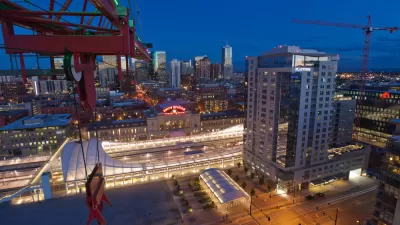A "green-collar job force" made up of low-income people is necessary to get those with fewer resources on the initially costly green living bandwagon, according to civil rights lawyer Van Jones.
"In 1996, Jones co-founded the Ella Baker Center for Human Rights-a nonprofit organization designed to keep kids off the streets and out of jails. And today he is trumpeting an idea that's disarmingly simple: Let's funnel the coming wave of jobs in sustainable industries toward those who most need them, creating a "green-collar" job force that gives the working poor and minorities a chance to get ahead while also ensuring that this new economy has a labor force behind it. In 2005, Jones and his staff of 20 people launched a campaign for green-collar jobs. Two years later, they convinced the Oakland City Council to fund the first-ever Green Jobs Corps, which will begin training its first recruits later this year in fields like installing solar panels, weatherizing buildings, and laying green roofs."
"The power of a solution that bridges economic and environmental development, explains Jones, is that it has the potential to unite traditionally disparate factions of the progressive movement. 'For at least a generation, activists of all constituencies have believed they could fix their problems on their own,' he says. 'But separatism won't work. On the environmental side, you'll end up leaving so many people out that they'll be undoing all the good and undermining your efforts.' On the social-justice side, says Jones, boosting wages with the same old dirty jobs inevitably ends up hurting the poor, accelerating problems like cancer and asthma."
FULL STORY: Black and Green

Pennsylvania Mall Conversion Bill Passes House
If passed, the bill would promote the adaptive reuse of defunct commercial buildings.

Planning for Accessibility: Proximity is More Important than Mobility
Accessibility-based planning minimizes the distance that people must travel to reach desired services and activities. Measured this way, increased density can provide more total benefits than increased speeds.

World's Largest Wildlife Overpass In the Works in Los Angeles County
Caltrans will soon close half of the 101 Freeway in order to continue construction of the Wallis Annenberg Wildlife Crossing near Agoura Hills in Los Angeles County.

Eviction Looms for Low-Income Tenants as Rent Debt Rises
Nonprofit housing operators across the country face almost $10 billion in rent debt.

Brightline West Breaks Ground
The high-speed rail line will link Las Vegas and the Los Angeles area.

Colorado Bans No-Fault Evictions
In most cases, landlords must provide a just cause for evicting tenants.
City of Costa Mesa
Licking County
Barrett Planning Group LLC
HUD's Office of Policy Development and Research
Mpact Transit + Community
HUD's Office of Policy Development and Research
Tufts University, Department of Urban and Environmental Policy & Planning
City of Universal City TX
ULI Northwest Arkansas
Urban Design for Planners 1: Software Tools
This six-course series explores essential urban design concepts using open source software and equips planners with the tools they need to participate fully in the urban design process.
Planning for Universal Design
Learn the tools for implementing Universal Design in planning regulations.


























